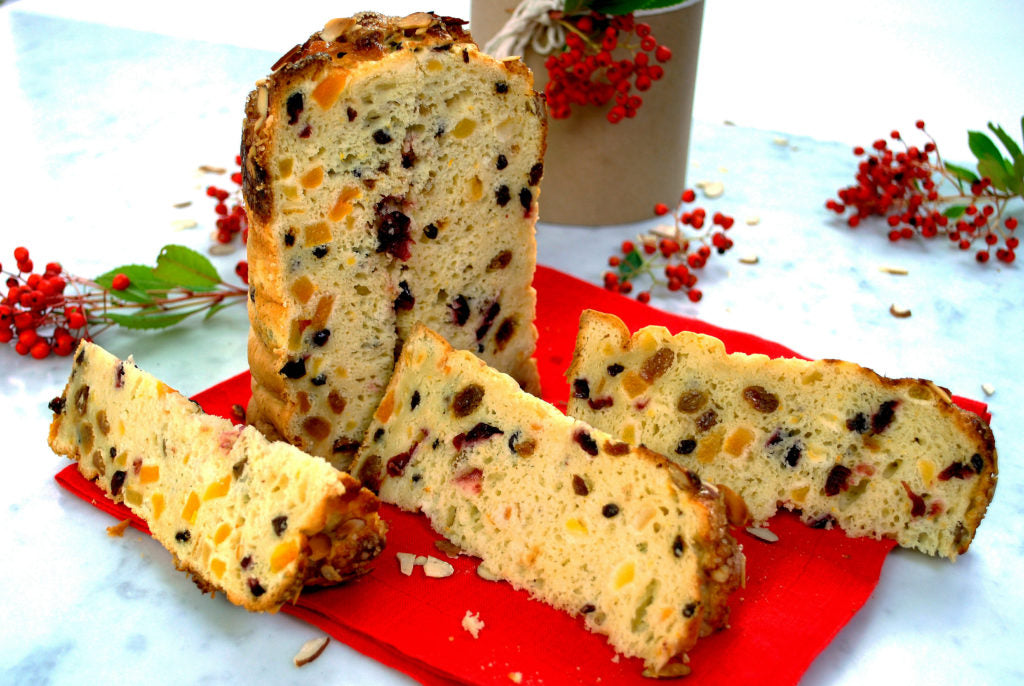Tall and buttery, and studded with fruit, this Panettone is an incredible treat for everyone, including those who thought they would never again enjoy this traditional Italian Christmas treat! Made with Pamela’s All-Purpose Flour.

- 1 coffee can (tin only with lip removed with can opener), or a Panettone pan, or any tin can 5-inch diameter and 6-inches tall, or two 5-inch diameter paper Panettone molds Fruit
- ½ cup dried apricots, cut in slivers
- ½ cup dried cranberries
- ½ cup currants
- ½ cup golden raisins
- ¼ cup orange juice or rum Sponge
- 1 TBSP active dry yeast
- 1 cup warm milk (max. 100°)
- 1 tsp sugar
- ½ cup Pamela's All-Purpose Flour (70 gr.) Dough
- 2¼ cups Pamela's All-Purpose Flour (315 gr.)
- 1½ tsp active dry yeast
- ¼ cup + 2 TBSP sugar
- 2 tsp coarse salt
- 3 eggs, beaten
- ¼ cup warm milk (up to ¼ more if dough is not very soft)
- orange zest from 1 small orange
- 1 tsp vanilla
- ¼ tsp orange extract (optional)
- 10 TBSP very soft butter
- ¼ cup slivered blanched almonds
- 1 TBSP melted butter Topping (optional)
- 1 egg, beaten
- 2 TBSP pearl or large crystal sugar
- 3 TBSP sliced almonds
Yield:
FRUIT
Chop any large pieces of fruit and soak fruit and raisins in rum or orange juice at least two hours, or 8 hours to overnight if fruit is very dry.
PREP TIN CAN
Spray sides and bottom of can with non-stick spray. To line the bottom of the can, roll out parchment paper to lay flat on a table. Set the can on the parchment paper and trace around the edge of the can. Make a circle 1-inch larger than the bottom of the can so that you now have 2 circles, an inner circle (the diameter of the can) and an outer circle (one inch larger in diameter than the can).

Cut around the larger outer circle first. To make tabs that will fit up the sides of the can from the bottom so that dough does not leak, make cuts from the outer circle into the inner circle (cutting towards the center) every ¾-inch.

Once the cuts have been made all the way around, center the circle at the top of the can and push the parchment to the bottom, using an offset spatula or other tool to help place it in the can.

Push the tabs up against the greased sides (which will hold them in place).

To line the sides of the can, cut a rectangular piece of parchment paper about 18 x 7½ inches (or one inch taller than your can). Roll the paper up slightly to fit it in the can, then nestle it down to the bottom and let the roll open to fit snugly to the greased sides of your can. Make sure to fit the side parchment in front of the tabs of the bottom circle. Where the paper overlaps itself, spray the edge so that the overlap will stick in place. There should be at least one inch or so of parchment above the top edge of the can when finished. Set can aside.

SPONGE: In the bowl of a stand mixer, sprinkle 1 TBSP yeast over warm milk mixed with 1 tsp sugar. Whisk together and let stand a minute, add ½ cup ARTISAN FLOUR, and whisk until smooth. Cover with plastic wrap and let stand in a warm spot 30 to 90 minutes (depending on how warm the environment is), until doubled. Prep and get ready all the dough ingredients while the sponge is rising.
DOUGH: Whisk the 2 ¼ cups flour together with remaining 1 ½ tsp yeast, 6 TBSP sugar, and salt. Add the flour mixture to the mixer bowl with sponge, along with eggs, ¼ cup remaining warm milk, zest, and extracts, and mix about a minute; the dough will strengthen. With mixer on low, add the very soft butter 1 TBSP at a time, mixing each time. Push down dough from the sides and paddle once or twice in the process of adding the butter. Mix in the slivered almonds and fruit, with any soaking liquid, until evenly distributed. You may have to use a silicone spatula to get the fruit completely well mixed throughout the dough.
The collar lining and tall sides will make it difficult to add the dough to the can. Use a large zip lock bag, spray the inside with non-stick spray and scrape the dough into the bag, eliminating any air bubbles, as you fill, and before you disburse. Cut a large tip off one corner of the bag and squeeze the dough into the pan. Start in the middle and make a coil around the outside, moving up into the center and then around the outside again until most of the dough is squeezed out, filling no more than 2/3 full. (There will be enough extra dough, about 2 cups, to make 4 large muffin sized individual Panettone.) Use a sprayed spatula to push the dough down into the pan, pushing out any air pockets; and flatten and smooth the top. Brush top liberally with 1 TBSP melted butter.
Tent with plastic wrap, and allow to raise in a warm draft-free location until doubled in size, about 60 to 90 minutes; the dough should just crest the top of the tin.
Preheat oven to 400°. Lightly brush the top of the Panettone with beaten egg, filling in any air holes bubbling up to the top. Sprinkle with sugar and almonds. (Repeat a second time if you want a really sugar and nut crusted top.) Much of the egg wash will be left over. Place on insulated cookie sheet or sheet pan to bake.
Bake in the middle of the oven at 400° (make sure you have enough room at the top-you may need to use the shelf one lower than the center), for 10 minutes. Reduce temperature to 375° and bake for 10 more minutes, reduce temp. to 350° and bake the remaining 35 to 40 minutes. Use a long, thin, wooden skewer to test for doneness; stick should come out clean, or test with instant read thermometer; should register at least 200° on removing from oven. Panettone should be a beautiful golden brown on top; cover loosely with foil in the last 15 minutes if getting too brown. The Panettone will have grown very tall but will settle a little shorter than when you remove from the oven, which is to be expected.
If using two of the pre-made Panettone paper molds: divide the dough in half. Spray and line with parchment bottom liner and parchment collar that is at least one inch taller than the mold. Reduce the final 350° cooking time by about 5 minutes.
If using large muffin cups or individual Panettone molds, along with the large loaf; they will be done after the first two cooking temps, in about 20 minutes.
VERY IMPORTANT: The Panettone will be very fragile. Allow to cool in the tin can, sitting on a wire rack. Once completely cool it will slide out of the can easily. If there are any points that seem to be sticking, use the offset spatula to carefully loosen.

Chef's Note: Feel free to substitute citron, candied orange or lemon peel for some of the dried fruits. An old Italian tradition uses clay pots lined with parchment.
© Pamela's Products, Inc.



